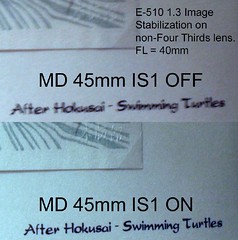Thanks to the persistence of Olympus users asking for the feature, and the hard work of the Olympus engineers, the E-510 (as well as the E-3) now supports Image Stabilization for non-Four Thirds lenses, including legacy optics. I had to try it out on one of my favorite lenses, the Minolta MD 45mm f/2.0 mounted to my Olympus E-510 using JR's MD to 4/3 adapter.
Here are the results of my first test shot.

As you can see, it works very well. Shot f/8 @ 1/13 second hand-held in dark room (under horrible compact fluorescent lighting...sorry for the terrible white balance). I just brought the out of camera JPEGs into Photoshop for a quick auto contrast and white balance.
To use IS on a such an ancient lens, you have to enter the focal length into a setting under the IS menu. To adjust the setting, hold down the exposure compensation button and turn the adjustment wheel until the correct focal length appears in the window. You're ready to shoot.
My testing shows the EXIF data does not recored the focal length entered into the setting. I wish they had provided it.
Here are the results of my first test shot.

As you can see, it works very well. Shot f/8 @ 1/13 second hand-held in dark room (under horrible compact fluorescent lighting...sorry for the terrible white balance). I just brought the out of camera JPEGs into Photoshop for a quick auto contrast and white balance.
To use IS on a such an ancient lens, you have to enter the focal length into a setting under the IS menu. To adjust the setting, hold down the exposure compensation button and turn the adjustment wheel until the correct focal length appears in the window. You're ready to shoot.
My testing shows the EXIF data does not recored the focal length entered into the setting. I wish they had provided it.
Comments